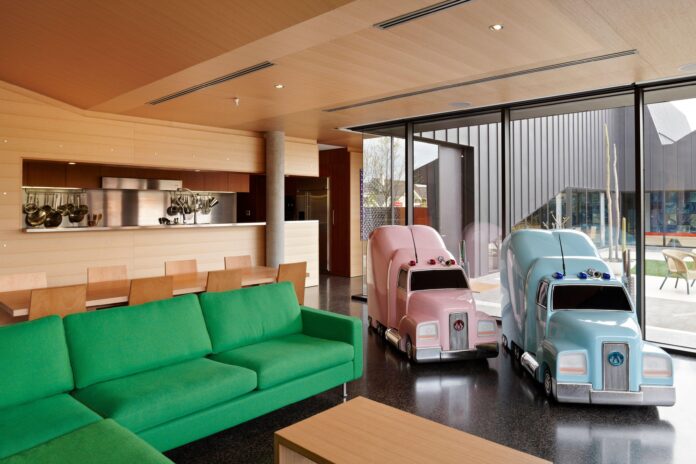Located on a large residential block in Kew, a suburb in Melbourne, Australia, the Lyon Housemuseum first opened its doors to the public in 2009. A decade later, Lyon erected a second building, the Housemuseum Galleries, on an adjacent block to stage exhibitions of contemporary art and design.
Fourteen years after he and his partner Yueji first invited the public to share in their bold living experiment, which included bringing up their two daughters, Carlin and Jaqlin, in the public gallery, the family is moving out. In the process, they’re setting up a foundation to give the buildings and their collection of contemporary Australian art, valued at A$56m, to the public.

The Lyon Housemuseum
Photo: John Gollins
According to Lyon, who designed both buildings, the housemuseum is not just a world-first concept. It’s a new architectural typology that combines two “seemingly irreconcilable buildings”—a museum and private residence — into an entirely new architectural form. “No one has designed a building from the ground up to be both in this hybrid way,” he says.
Around the world, there are examples of private houses that have evolved into museums, such as the late architect John Soane’s Museum in London and Peggy Guggenheim’s eponymous art museum in Venice. These inspired Lyon to pursue the idea himself, but he took it further by opening his home to the public. As he tells The Art Newspaper, the reason for the scarcity of such housemuseums is perhaps obvious: not many people are able to “rise to the challenge” of having the public traipse through their home on a regular basis.

The installation ENTER at the Lyon Housemuseum
Photo: Tobias Titz
Initially, he says, it took “some fortitude”. But the Lyon family soon adapted, driven by a desire to share their art collection and the concept with the public. To this day, the couple still host all public tours of the Lyon Housemuseum themselves. Visitors like to hear “from the people who have been the collectors,” says Lyon. But they can also find it a confronting concept. “They can see we’ve had breakfast, but they can also see it’s a museum… that’s what makes it a really interesting experience.”
Since it opened, an estimated 20,000 people have visited, although Lyon believes the actual figure is much higher. There have never been any issues: “People are very respectful,” he says.
An idiosyncratic snapshot
Lyon’s art collection began in 1990, when he purchased two pieces: Nude in a Landscape (1989) by Linda Marrinon and Orange Building Site (1990) by Louise Forthun. Since 1994, he and Yueji have jointly acquired some 350 works by around 60 of Australia’s best-known artists.
Surrounded by their collection, the Lyons have grown close to certain works and to the artists, often developing long-lasting friendships as they collect their work in depth over the course of their careers.
In the family’s kitchen, which during opening hours doubles as the housemuseum’s café, sits Patricia Piccinini’s Truck Babies (1999), two pastel-coloured miniature semi-trailers, about the size of large boulders. They were acquired by the Lyons in 1999, a time when most Australian collectors found the artist’s work “too weird,” according to Lyon.

Howard Arkley’s Fabricated Rooms (1997-99)
Photo: Dianna Snape
Upstairs in the Lyon Housemuseum’s dining room hangs the work of another Venice alumni, the late Howard Arkley’s Fabricated Rooms (1997-99), amulti-panelled airbrush painting of the interior of a sparsely furnished Australian home. “I replicated how that was shown in Venice,” says Lyon.
Thirty-three years of collecting have created an idiosyncratic snapshot of Australian contemporary art since 1990. But what makes it truly unique is the housemuseum setting, which will become a time capsule of Australian contemporary art from this period.
In June this year, a wall that separates the Lyon Housemuseum and the Housemuseum Galleries will be demolished, allowing visitors to wander between the galleries’ conventional “white cubes” and the original housemuseum. And “in a few more years,” says Lyon, the couple will cease adding to the collection. Their hope is that, much like the Peggy Guggenheim Collection in Venice, “even though the collector has stopped collecting, it’s still a fascinating place to visit”.

























